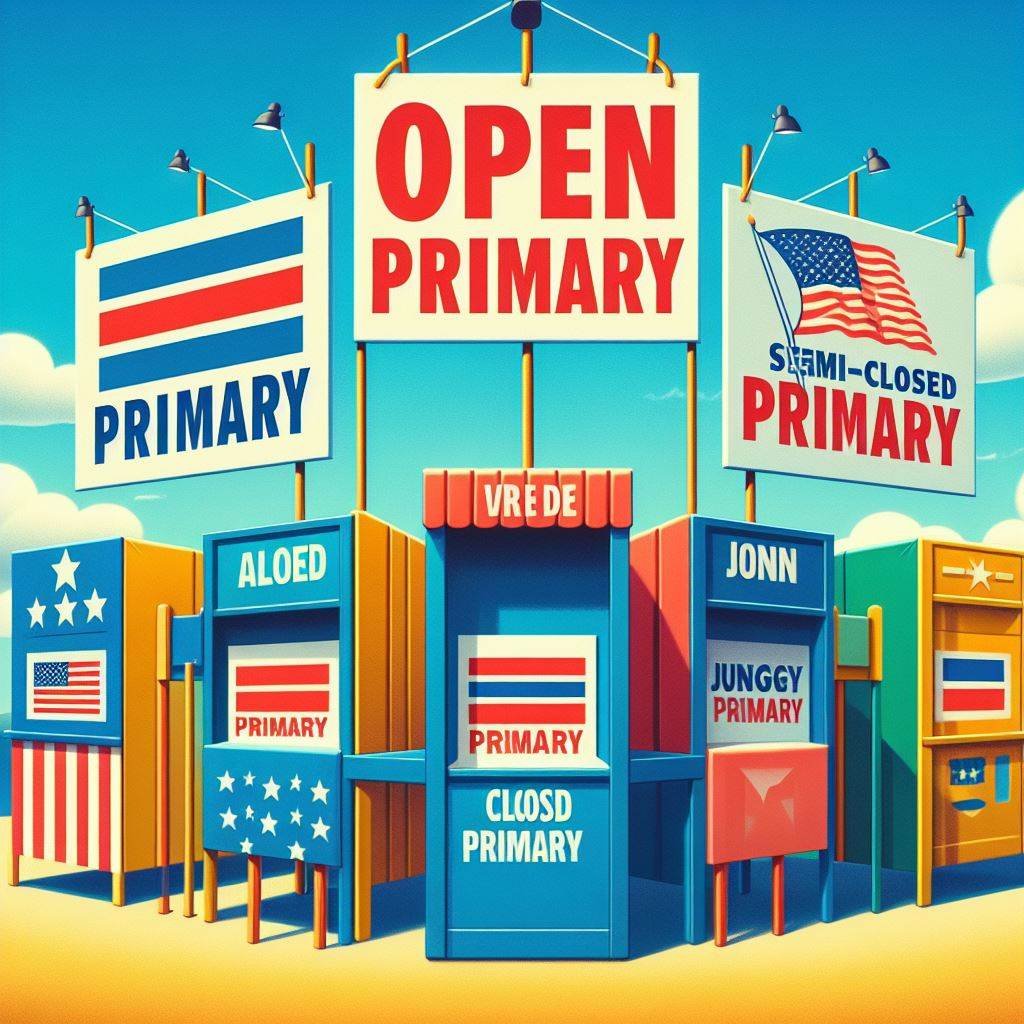Primer on Primaries: State-Level Snapshot of Different Primary Election Types
Generated with AI: An image of voting booths with signs indicating “Open Primary,” “Closed Primary,” “Semi-Closed Primary” and "Jungle Primary" that represent the different options available to voters. The booths are colorful and have different shapes and sizes. The signs are clear and easy to read. The background is a bright blue sky with some clouds. The image conveys a sense of democracy and hope.
Primary vs. General Elections
Many Americans don't vote or feel their vote doesn't carry significant weight, especially during primary elections. However, the “primaries” hold a crucial role in shaping our democracy. So, what is a primary election, and how does it differ from the general?
Well, primary elections are one of the first steps in the US electoral process. It’s when voters like you decide which candidates will represent a political party in the general elections. In comparison, when you vote in the general elections, you help decide who will officially win the job of public office for positions like president, senator, governor, and more.
Why Primaries Matter?
Primaries offer a unique opportunity for you to influence which candidates will represent each party in the general elections. It’s your chance to vote for the option you feel best aligns with your values and future priorities. Whether you’re a staunch party loyalist, a centrist, or an independent, primaries are where your influence truly counts.
Types of Primaries
Did you know that not all primary elections are the same? Let’s explore the various types of primaries and how they impact voters in my home state, Texas.
1. Open Primaries
In open primaries, you’re free to choose either the Democratic or Republican ballot without having to register with that party in advance. Texas primarily operates under this system. Here voters can influence the candidate selection process across the political spectrum. However, it's worth noting that once you participate in one party's primary, you’re restricted from voting in the other party's runoff elections.
States that use open primaries include the following:
2. Closed Primaries
In closed primaries, you must register for a specific party to vote on that ballot. Only Democrats can vote in the Democratic primary and Republicans in the Republican primary. The system tends to strengthen party loyalty but can also lead to the nomination of extreme candidates who strongly represent their party's values and policies.
In Texas, some local party organizations may hold closed primaries for specific races. For example, in Burnet County, the most recent primary election is split between Democrats and Republicans. Voters stand in separate lines based on their party affiliation vs. just noting upon check-in which party’s ballot they want.
States that use open primaries include the following:
Connecticut Delaware Florida Kentucky Maine Maryland Nevada New Mexico New York Oklahoma Oregon Pennsylvania South Dakota Utah Washington, D.C. Wyoming
3. Semi-Closed or Semi-Closed Primaries
Semi-closed primaries blend elements of both open and closed systems. Registered party members stick to their party’s primary, while unaffiliated voters can choose.
Texas' approach can be described as semi-open because, while voters do not have to declare party membership to vote in a primary, your choice of party in a primary election is a public record. This method strikes a balance, allowing for voter flexibility while still maintaining a level of party structure within the primary process.
States that use open primaries include the following:
Arizona Colorado Idaho Kansas Massachusetts New Hampshire New Jersey New York North Carolina Oklahoma Rhode Island South Dakota Utah West Virginia
4. Blanket, Top-Two or Top-Four Primaries
Blanket primaries allow voters to select candidates from any party for each office.
In the top-two primaries, all candidates, regardless of party, compete in a single primary. The two highest vote-getters advance to the general election. As of September 2023, three states use a top-two primary system for some elections: California, Washington, and Nebraska. Because Nebraska's state legislature is nonpartisan, party affiliation labels are not listed alongside the names of state legislative candidates.
Alaska established a top-four primary in 2020. It runs similarity to the top-two but includes the top four candidates.
5. Jungle Primaries
The Jungle Primaries, also known as the Louisiana Majority-Vote System, is wild. Here’s how it works: there is one giant ballot that lists all candidates running for all offices. To win outright, a candidate needs 50 percent of the votes plus just one more vote. But if no one reaches that magic number, the top two finishers faceoff in the “jungle runoff.” In this rematch, the person with the most votes wins.
Summary
Remember: primary elections play a crucial role in shaping the candidates who eventually compete in the general elections. Make your voice heard!
Civic Call to Action
Register and Participate
For more detailed information about each state’s primary election type, you can explore resources like Ballotpedia or the National Conference of State Legislatures.
Register: To vote in any primary, you must be a registered voter.
Participate: Don’t skip primaries. Your voice matters here, shaping the political land.
